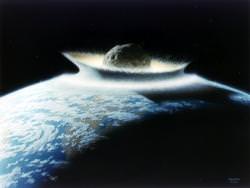Does this mean that, perhaps, we can go home again?
If an asteroid or comet impacted Earth, the resulting ejection of materials could contain life forms. According to a study published in the journal Astrobiology, these life forms could survive and then seed another planet or moon with life. Additionally, Earth could also be re-seeded with life by those same life forms.
Ah, there’s no place like home.
If rock fragments containing embedded microorganisms were ejected into space, at least some of those organisms might survive and reseed Earth or seed another planetary surface able to support life. This scenario, which is called lithopanspermia was examined in studies called systematic shock recovery experiments designed to simulate this type of situation where microorganisms are transported between planets via meteorites.
The researchers sandwiched dry layers of three kinds of biological test ingredients, including bacterial endospores, endolithic cyanobacteria, and epilithic lichens, into rocks analogous to rocks from Mars. They then simulated the shock pressures Martian meteorites experienced when they were ejected from Mars and determined the ability of the organisms to survive the harsh conditions.
The organisms are hardy examples of microbes that can withstand extreme environmental stress and represent potential ‘hitchhikers’ within impact-ejected rocks.
“Given that impacts have occurred on planetary bodies throughout the history of our solar system,” says Sherry L. Cady, PhD, Associate Professor in the Department of Geology at Portland State University, “the hypothesis that life in rock could have been transferred between planets at different times during the past 3.5 billion years is plausible.”
And not only is it plausible that Mars rocks could be transferred to Earth and vice versa, but ejected rocks from Earth could possibly return and land back on their home planet. Given the contemplation of the destruction of life on Earth, it’s somewhat comforting to think that we could perhaps start over again from our own ingredients.
Original News Source: Astrobiology Press Release


Looks like the ‘National Enquirer’ [gad, I don’t think I can even spell it!] strikes again!!!
This is a plausible assumption which could actually be verified in the foreseable future. If by impact ejected rocks have surviving lifeforms, then lets collect a few. They should be out there, most likely circelling the earth. If such microbes are indeed found, then of course one wonders whether they originate from earth, mars or , yes, from another solarsystem!? The latter will be hard to accertain but if more than 2 origins are confirmed…..it will start building a case for itself.
Endospores, lichen, cyano-endoliths, what kind of life we lookin for? Let’s just take care of this globe so we don’t wind up imprisoned in some impact-protective rock. I couldn’t handle the lifestyle change!
Jaap,
Our best bet for confirming this is to actually find a rock on the surface of the planet that has been confirmed from another celestial body. Im not sure, but most objects orbiting the planet are travelling at very high speeds.
Interesting hypothesis. I wonder what the study folks figured a meteorite impact mass/velocity ratio typically is for ejecta of anykind to reach earth’s escape velocity of six miles per second?
the notion that we could concievably impregnate another planet… this sounds like a reach to me…. albeit I will admit that the idea sounds plausible.
Drew — What on Earth do hot Latina pornos have to do with panspermia theory, anyway?
hope this day will never come….
>> Given the contemplation of the destruction of life on Earth, it’s somewhat comforting to think that we could perhaps start over again from our own ingredients.<<
Comforting in some wonder-ticking fantasy world reverie maybe, but astronomically, it’s nonsense.
Martian meteorites are one thing; Mars is very small, its gravity is small, its orbit is outside that of Earth. But the Earth is massive by comparison, and so massive in fact that only the largest impacts might send Earth rock into orbit where it might possibly–but only barely and so most improbably–reach Mars. So Earth meteorites on Mars are a completely different thing. It isn’t that easy.
Then the author adds that by sheer chance, life from Earth could have survived the required colossal impact; and could have, by sheer chance, survived being transported to Mars where it improbably flourished; and then, by sheer chance, been once again subjected to a random impact that sent it into orbit and that it, by sheer chance, survived another most improbable space journey and found its way back to Earth. It’s all so improbable, so implausible that it’s laughable. What scientific question does this answer? None. It’s nothing but wonder-tickling speculation unfettered by astronomical realities and informed scientific realism’s practical skepticism. It’s Nonsense.
Life evolved on Earth, took a completely unnecessary, long, all but impossible and certainly implausible round-trip journey to Mars completely without consequence and is indistinguishable from having never left. Hmmm? Lacking concrete evidence from beginning to end of the reality of this seemingly most implausible of hypotheses, it doesn’t even rise to the level of falsifiability. It’s a wild answer to a nonexistent question.
So besides its astronomical, biological and practical improbabilty and obvious implausibility–contrary to the article’s bizarre claim of plausibility–it fails to satisfy several tests for the validation of a theory as scientific according to Popperian demarcation.
Interesting…! 🙂